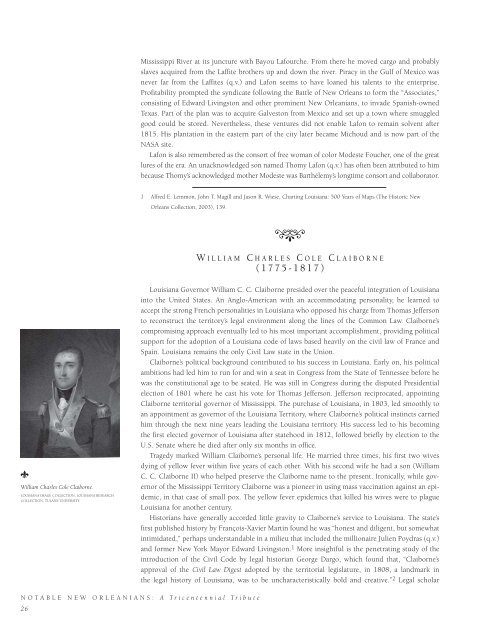Notable New Orleanians: A Tricentennial Tribute
An illustrated history of New Orleans paired with the histories of companies that have helped shape the city.
An illustrated history of New Orleans paired with the histories of companies that have helped shape the city.
Create successful ePaper yourself
Turn your PDF publications into a flip-book with our unique Google optimized e-Paper software.
Mississippi River at its juncture with Bayou Lafourche. From there he moved cargo and probably<br />
slaves acquired from the Laffite brothers up and down the river. Piracy in the Gulf of Mexico was<br />
never far from the Laffites (q.v.) and Lafon seems to have loaned his talents to the enterprise.<br />
Profitability prompted the syndicate following the Battle of <strong>New</strong> Orleans to form the “Associates,”<br />
consisting of Edward Livingston and other prominent <strong>New</strong> <strong>Orleanians</strong>, to invade Spanish-owned<br />
Texas. Part of the plan was to acquire Galveston from Mexico and set up a town where smuggled<br />
good could be stored. Nevertheless, these ventures did not enable Lafon to remain solvent after<br />
1815. His plantation in the eastern part of the city later became Michoud and is now part of the<br />
NASA site.<br />
Lafon is also remembered as the consort of free woman of color Modeste Foucher, one of the great<br />
lures of the era. An unacknowledged son named Thomy Lafon (q.v.) has often been attributed to him<br />
because Thomy’s acknowledged mother Modeste was Barthélemy’s longtime consort and collaborator.<br />
1 Alfred E. Lemmon, John T. Magill and Jason R. Wiese, Charting Louisiana: 500 Years of Maps (The Historic <strong>New</strong><br />
Orleans Collection, 2003), 139.<br />
<br />
W ILLIAM C HARLES C OLE C LAIBORNE<br />
(1775-1817)<br />
<br />
William Charles Cole Claiborne.<br />
LOUISIANA IMAGE COLLECTION, LOUISIANA RESEARCH<br />
COLLECTION, TULANE UNIVERSITY.<br />
Louisiana Governor William C. C. Claiborne presided over the peaceful integration of Louisiana<br />
into the United States. An Anglo-American with an accommodating personality, he learned to<br />
accept the strong French personalities in Louisiana who opposed his charge from Thomas Jefferson<br />
to reconstruct the territory’s legal environment along the lines of the Common Law. Claiborne’s<br />
compromising approach eventually led to his most important accomplishment, providing political<br />
support for the adoption of a Louisiana code of laws based heavily on the civil law of France and<br />
Spain. Louisiana remains the only Civil Law state in the Union.<br />
Claiborne’s political background contributed to his success in Louisiana. Early on, his political<br />
ambitions had led him to run for and win a seat in Congress from the State of Tennessee before he<br />
was the constitutional age to be seated. He was still in Congress during the disputed Presidential<br />
election of 1801 where he cast his vote for Thomas Jefferson. Jefferson reciprocated, appointing<br />
Claiborne territorial governor of Mississippi. The purchase of Louisiana, in 1803, led smoothly to<br />
an appointment as governor of the Louisiana Territory, where Claiborne’s political instincts carried<br />
him through the next nine years leading the Louisiana territory. His success led to his becoming<br />
the first elected governor of Louisiana after statehood in 1812, followed briefly by election to the<br />
U.S. Senate where he died after only six months in office.<br />
Tragedy marked William Claiborne’s personal life. He married three times, his first two wives<br />
dying of yellow fever within five years of each other. With his second wife he had a son (William<br />
C. C. Claiborne II) who helped preserve the Claiborne name to the present. Ironically, while governor<br />
of the Mississippi Territory Claiborne was a pioneer in using mass vaccination against an epidemic,<br />
in that case of small pox. The yellow fever epidemics that killed his wives were to plague<br />
Louisiana for another century.<br />
Historians have generally accorded little gravity to Claiborne’s service to Louisiana. The state’s<br />
first published history by François-Xavier Martin found he was “honest and diligent, but somewhat<br />
intimidated,” perhaps understandable in a milieu that included the millionaire Julien Poydras (q.v.)<br />
and former <strong>New</strong> York Mayor Edward Livingston. 1 More insightful is the penetrating study of the<br />
introduction of the Civil Code by legal historian George Dargo, which found that, “Claiborne’s<br />
approval of the Civil Law Digest adopted by the territorial legislature, in 1808, a landmark in<br />
the legal history of Louisiana, was to be uncharacteristically bold and creative.” 2 Legal scholar<br />
NOTABLE NEW ORLEANIANS: A <strong>Tricentennial</strong> <strong>Tribute</strong><br />
26
















